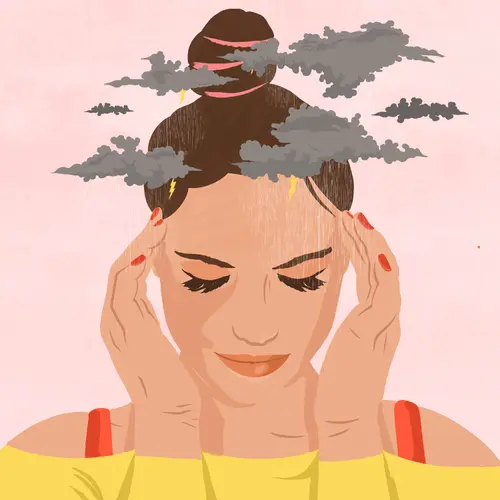Migraine with brainstem aura or MBA (formerly known as basilar migraines) are headaches that start in the lower part of the brain, called the brainstem. They cause symptoms such as dizziness, double vision, and lack of coordination. These changes, called an aura, can happen about 10 minutes to 45 minutes before your head hurts. The headache pain of a basilar migraine often starts on one side of the head and then gradually spreads and gets stronger.
This type of migraine can last anywhere from 4 to 72 hours. And it takes time to recover from one. You may feel drained for up to 24 hours after it’s over.
Migraines with brainstem aura are known by several different names:
- Basilar migraine
- Basilar artery migraine
- Basilar-type migraine
- Bickerstaff's syndrome
- Brainstem migraine
- Vertebrobasilar migraine
Who's at Risk for Migraine with Brainstem Aura?
MBA can affect people of all ages. Generally, though, they start in childhood or the teen years. Women are slightly more likely to have them than men.
What Causes Migraine with Brainstem Aura?
Triggers may include:
- Alcohol
- Stress
- Lack of sleep
- Some medications
- Hunger
- Female hormone changes
- Bright lights
- Caffeine
- Nitrites in some foods, like sandwich meat, bacon, and processed foods
- Overdoing physical activity
- Weather or altitude
What Are the Symptoms of Migraine with Brainstem Aura?
Symptoms differ for everyone, but some are typical:
- Nausea
- Vomiting
- Sensitivity to light and sound
- Cold hands or feet
- Dizziness
- Double vision or graying of vision
- Slurred speech or trouble speaking
- Temporary blindness
- Loss of balance
- Confusion
- Trouble hearing
- Body tingling
- Loss of consciousness
Aura symptoms may last between 5 minutes and 1 hour. When the headache starts, you might feel an intense throbbing or pulsating pain on one or both sides of your head or sometimes at the back of your head. Some of these symptoms can also happen with life-threatening conditions such as stroke. So if you have any symptoms included in the last nine bullet points above and they have not been diagnosed as an MBA, get emergency medical help right away.
How Are Migraines with Brainstem Aura Diagnosed?
After you’ve had at least two attacks of at least two auras, your doctor may make the diagnosis of MBA.
The condition has many of the same symptoms as another type, called hemiplegic migraine. But the hemiplegic kind usually causes weakness of one side of the body or trouble speaking.
Symptoms of MBA can also seem like the signs of other more serious conditions, like seizure disorders, stroke, meningitis, or brain tumors. To rule those out, you’ll need to see a brain doctor, called a neurologist. They’ll give you a thorough exam and ask you questions about your symptoms. They may also use tests like MRI, CT scans, and nerve tests to see what’s causing your symptoms.
How Are Migraines with Brainstem Aura Treated?
Treatments for MBA generally aim to relieve symptoms of pain and nausea. You might take pain relievers such as acetaminophen (Anacin, Panadol, Tylenol), ibuprofen (Advil, Motrin), and naproxen (Aleve, Anaprox, Naprosyn). For more severe symptoms or nausea your doctor may prescribe medicines such as ketorolac, celecoxib (Celebrex, Elyxyb), metoclopramide (Reglan), and prochlorperazine (Compro). Newer treatments include the CGRP antagonists rimegepant (Nurtec) and atogepant (Qulipta) and the serotonin 1F receptor agonist lasmiditan (Reyvow). Acute migraine medicines like triptans and ergotamines will not be given because of the possible risk of stroke.
Can Migraines with Brainstem Aura Be Prevented?
To keep from getting an MBA, it helps to avoid the things that usually cause one. Keep a journal of your attacks so you can figure out the things that trigger them. It also helps to live a healthy lifestyle. That means you need to:
Diet can also affect migraines. Do these things:
- Eat a balanced diet.
- Avoid drugs and alcohol.
- Don’t skip meals.
- Limit caffeine.
- Avoid any foods that have been triggers.
Some common food triggers include:
- Dairy
- Wheat
- Chocolate
- Eggs
- Rye
- Tomatoes
- Oranges
Along with these changes, If you don’t respond to other treatments and you have 4 or more migraine days a month, your doctor may suggest preventive medicines. You can take these regularly to reduce the severity or frequency of the headaches. These include seizure medicines, blood pressure medicines (like calcium channel blockers), and some antidepressants. CGRP inhibitors are a newer class of preventive medicine that your doctor may recommend if other medicines don’t help. Preventive migraine medicines like beta blockers may be avoided because of the possible risk of stroke.

